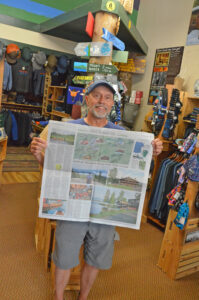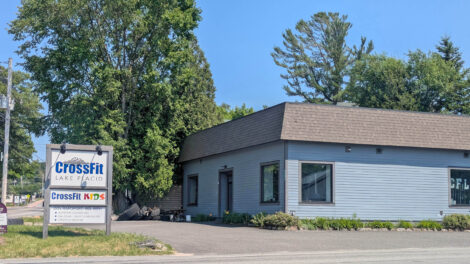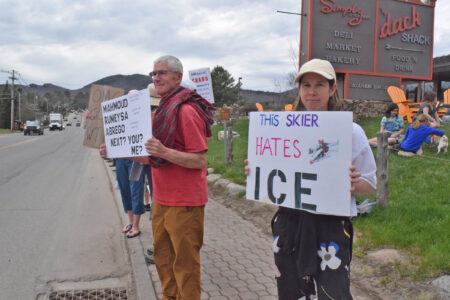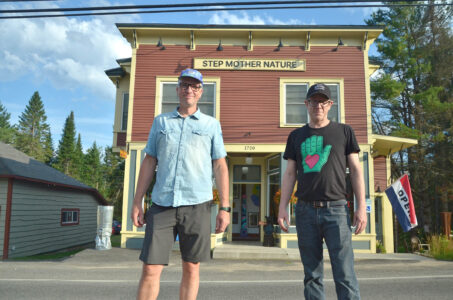Tree killer outbreak is worse than thought
Satellite imagery will be used to fight hemlock woolly adelgid at Lake George campsite
- A bicyclist on the Warren County Bikeway passes by a billboard raising awareness for hemlock woolly adelgid — an invasive species that has recently been confirmed to have multiple infestations in the Adirondacks in 2020 — along Beach Road in Lake George on Sunday afternoon. (Provided photo — Jackson Gerker, The Post-Star)
- Hemlock woolly adelgid (Photo provided — New York State Department of Environmental Conservation)

A bicyclist on the Warren County Bikeway passes by a billboard raising awareness for hemlock woolly adelgid — an invasive species that has recently been confirmed to have multiple infestations in the Adirondacks in 2020 — along Beach Road in Lake George on Sunday afternoon. (Provided photo — Jackson Gerker, The Post-Star)
LAKE GEORGE — An infestation of hemlock woolly adelgid discovered at a campsite off Lake George last month is more widespread than initially anticipated, an official from the state Department of Environmental Conservation said Tuesday.
Last month’s discovery of the invasive species at the Glen Island Campground now covers at least 250 acres on the eastern side of Lake George and dates back at least five years, said Rob Davies, DEC’s director of Division of Lands and Forests.
“The infestation that we are finding is older than we hoped, and larger than we had hoped,” he said.
Last month’s discovery is the second time hemlock woolly adelgid has been discovered in the Lake George basin in recent years. An infestation was discovered on Prospect Mountain in 2017 but has since been eradicated.
Davies said it’s unclear which infestation came first, but noted that birds may have played a role helping spread the invasive insect from one part of the Lake George basin to another.

Hemlock woolly adelgid (Photo provided — New York State Department of Environmental Conservation)
“It does seem as though birds played a role,” he said.
Approximately 80% of the trees that surround the Lake George basin are hemlocks, making the discovery of the invasive insect all the more troubling.
The insect, which comes from Asia, can kill a tree within four to 10 years.
To combat the spread, DEC has entered into a public-private partnership to launch a pilot program that will use satellite imagery to detect the species early on, which will allow ground crews to be deployed to areas of the Lake George basin that may be infected by hemlock woolly adelgid.
The $125,000 program was made possible through a partnership with The Fund for Lake George, the Adirondack Park Invasive Plant Program, Lake George Land Conservancy, City University of New York’s Advanced Science Research Center, Cornell’s New York State Hemlock Initiative, U.S. Forest Service and Adirondack Research.
“This is an all-hands-on-deck … effort to save our Lake George hemlocks,” said Eric Siy, executive director of The Fund for Lake George.
The program is part of the “Save Our Lake George Hemlock Initiative” and will be rolled out in four stages over the next couple of months. Crews have already started the program’s first phase, which is detection, and plan to begin treating infected trees in the coming weeks under the program’s second phase.
During the program’s third phase, surveillance crews will examine satellite imagery to detect changes in hemlock trees. From there, ground crews will be deployed to inspect any troubled areas, and insecticides will be deployed to kill any infestations that are found.
The program will cover 4,400 square miles and will extend to the southern portion of the Lake George basin to Troy in Rensselaer County.
Davies said detecting hemlock woolly adelgid is no easy task. The species can be hard to spot even when up close, and with so many trees that could possibly be infected, knowing where to look is vital.
“Early detection of hemlock woolly adelgid is a real challenge,” he said. “It’s very difficult to find on the ground.”
The program will use freely available satellite sources, including NASA’s Landsat and the European Space Agency’s Sentinel, said Andrew Reinmann, an assistant professor with CUNY’s Advanced Science Research Center.
“You can sort of think of these satellites as collecting just digital images much like our cameras would do,” he said.
Healthy hemlock trees would appear a darker shade of green compared to those that are infected, Reinmann said.
There are plans to eventually roll the program out on a state level and incorporate other satellites and technologies to identifying infected trees, but nothing is set in stone just yet. Siy said plans will continue to be developed in the months ahead.
“This isn’t a sprint, it’s a marathon,” he said.






